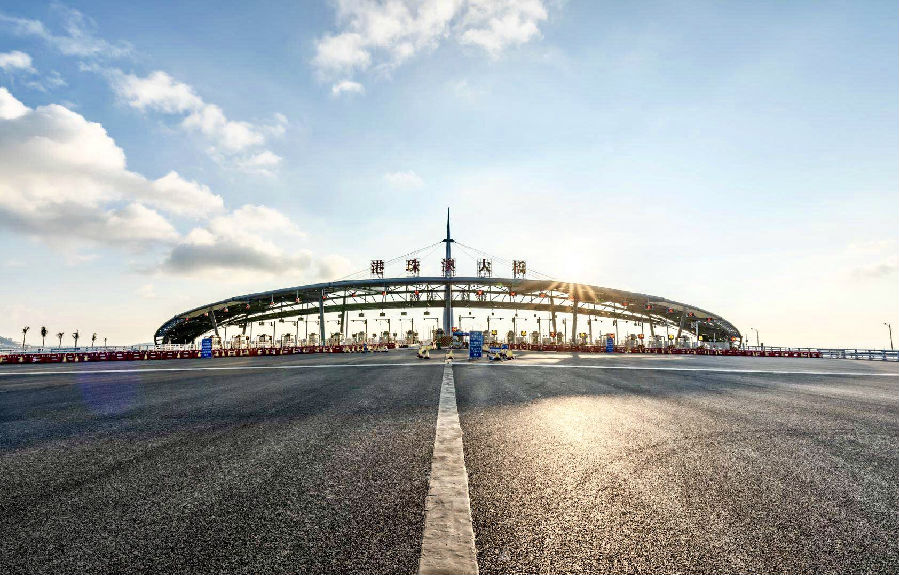When the Hong Kong-Zhuhai-Macau Bridge, orHZMB, was completed in January of 2018,
2018年1月,港珠澳大桥竣工,
it became the longest sea crossing bridge in theworld.
成为当今世界上最长的跨海大桥。
With a total length of 55 kilometers, the structure isimpressive to behold,
该桥全长55公里,桥的结构光是看上一眼就会给人留下深刻的印象,
but the engineering behind it is even moreincredible.
但这一结构背后的工程学更加让人难以置信。
The goal of the bridge was to connect
这座桥的目标是连接
the major population center of Hong Kong on one side of the Pearl River Delta to Macau andZhuhai on the other.
珠三角一头的香港这一人口大区和另一头的澳门和珠海。
Normally to go between the cities requires driving around a large bay,
在这三个城市之间穿行通常需要开车绕过一个大海湾,
and a more direct path could take two hours off the trip.
而更直接的路线可以让人们节省两个小时的车程。
Making such a long bridge required careful planning from the HZMB’s designers.
要建造这样一座大桥,港珠澳大桥的设计者们需要进行精心的规划和设计。
They had to build it to withstand the annual typhoon season, the occasional earthquake, andthe ever-present sea.
要让建造出来的桥能够抵御每年都有的台风季,偶尔发生的地震,以及始终都在那里的大海。
And their goal is to make it last for for 120 years.
而他们的目标是让这座桥(在这样的条件下也)能延续120年。
They also had to account for its location,
他们还要考虑这座桥的位置:
cutting across five shipping navigation channels
这座桥将横跨五个航运航道,
and the flight path of aircraft taking off and landing at Hong Kong International Airport.
还要经过香港国际机场的起降航线。
And finally, they had to consider the local marine life, like the chinese white dolphin,
最后,他们还要考虑当地的海洋生物,比如中华白海豚,
and the impact the construction and presence of the bridge would have on the ecology ofthe region.
以及桥梁的建设和存在将对该地区的生态产生的影响。
The first most obvious challenge when building over water is the fact that there’s no land tobuild on.
在水上架桥的第一个最明显的挑战是没有土地可以依托。
That’s kind of the whole point of the bridge.
这恰好也是港珠澳大桥整座桥最关键的地方,
So you need to start with a stable base.
所以,首先,他们得给桥打一个稳定的基础。
However the first solid ground you run into under water isn’t usually ideal either.
然而,你在水下遇到的第一个相对坚固的地面通常并不是理想的打桩之地。
In this case, there were weak marine deposits that don’t make for a solid foundation.
就拿架桥来说,不那么坚固的海洋沉积物就无法打造成坚实的桥梁基础。

To overcome this, builders drove long poles called piles down through the sediment.
为了克服这一困难,施工的工人们会把所谓的“(钢管)桩”这种长杆打入海底的沉积物。
Piles used in the Hong Kong link road portion of the bridge could be as wide as 2.8 meters,
港珠澳大桥香港一侧的辅路部分所有的钢管桩宽度可达2.8米,
and in a few cases were over 100 meters long to reach a stable foundation.
为了实现桥基的稳定,有的钢管桩的高度甚至超过了100米。
With the piles in place, workers put a cap over them.
钢管桩就位后,工人们便对其进行封顶。
HZMB designers placed many of these caps under the sea floor in order to minimize theirimpact on the flow of water.
为了尽可能减小大桥对水流的影响,港珠澳大桥的设计师们进行了多处封顶操作。
From the pile cap rises a single column called a pier, and spans with the road surface on themstretch from one pier to the next.
在这些顶盖上立起单柱,即所谓的“桥墩”,再支起桥台,桥台上则承载着从一个桥墩延伸到另一个桥墩的路面。
To minimize the number of piers and reduce the ecological impact,
为尽量减少桥墩数目,缩小对生态的影响,
long spans of up to 180 meters were used where applicable.
他们将桥台设计得较长,有的桥台长度甚至达到了180米长。
These long spans are strong enough to support themselves in between piers,
这些长跨度的桥台非常坚固,足以支撑起它们在两个桥墩之间的自重。
but they’re still not long enough to leave a gap for the large vessels that use those five majorshipping lanes into the bay.
但即便如此,这些桥台的长度还是不够容纳靠这五条主要航道出入海湾的大型船只。
For those portions of the bridge, engineers had to switch up their design.
对于桥梁的这些部分,工程师们不得不改变设计。
Across three of the lanes, they used a cable-stay bridge design,
在经过五个航道中的三个航道的位置,设计师们采用了斜拉桥的设计,
where large towers are anchored with cables directly to the deck.
巨大的索塔直接用缆索固定在桥面上。
The towers absorb the compression forces on the spans.
索塔会消化路面对桥台的部分压力。
For two of those navigation channels through, cable-stayed bridges were not an option.
在另外两条(深海主)航道经过的地方,斜拉桥这种设计就不可行了。
The tall towers would pose a risk to flights from the nearby airport.
因为高高的索塔会对往返附近(香港赤喇角)机场的航班构成威胁。
So the designers decided to take part of the bridge underwater.
于是,设计师们决定将这一部分桥体放到水下。
6.7 kilometers of the HZMB’s length is a tunnel,
港珠澳大桥有6.7公里都是海底隧道,
connected to the bridge with an artificial island on each end.
两端各通过一座人工岛与水上部分的桥体相连。
This solved the air and sea traffic problems in one fell swoop,
这一设计一举解决了海空两方面的交通问题,
but posed another problem for the local marine life.
但也给当地海洋生物带来了麻烦。
The usual process of making artificial land starts with dredging out the muck on the seafloorand filling it with sand,
因为搭建人工岛通常要先挖掉海底的淤泥继而填上沙子,
then building a sea wall on top of that and finally filling in the area within the sea wall.
之后在上面建一个海堤,最后填满海堤内的区域。
But the process of dredging muddies the water with disturbed and dumped sediment.
问题是,疏浚的过程会使泥沙淤积在水中。
This suspended sediment can consist of organic material, nutrients, or contaminants thataffect the ecosystem in positive and negative ways.
悬浮的沉积物可能含有会给周围的生态系统造成或正面或负面影响的有机物、营养物质或污染物。
When the dust settles, it can blanket and smother communities living on the seabed.
泥沙沉积后还会覆盖,甚至窒息生活在海底的生物群。
Past projects that used dredging have played a part in the decline of the Chinese WhiteDolphin population in the area.
过去的疏浚工程就对该地区中国白海豚数量的减少产生了一定的影响。
To try and avoid harming the dolphin population further the builders used a completelydifferent approach.
为了避免进一步伤害海豚种群,建造者这次使用了截然不同的一种方法。
First they installed a matrix of stone columns running down to the sturdier sand and clay.
他们先安装了一排石柱,这些石柱直接打入相对坚硬的沙子和粘土层。
Then they drove
